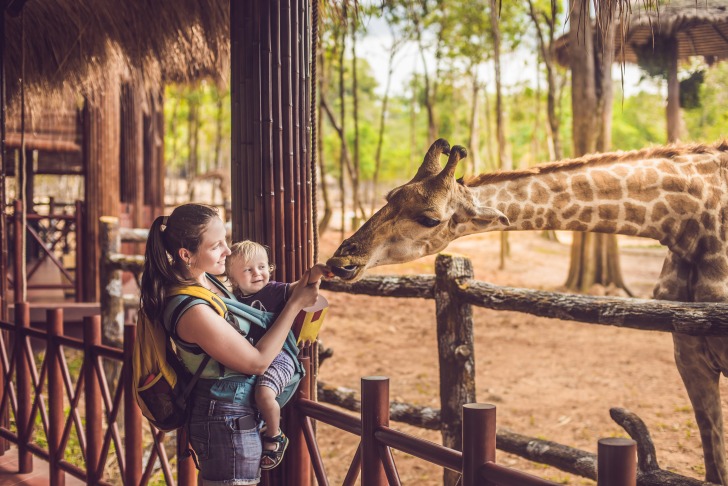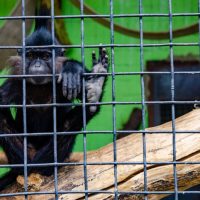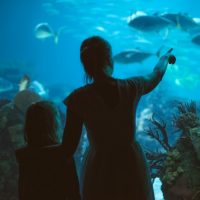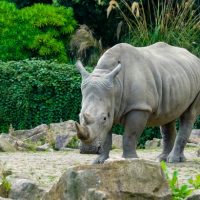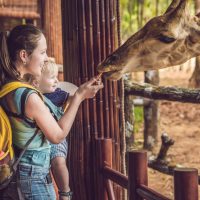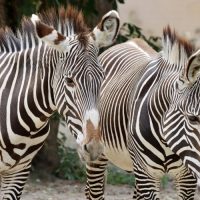Maryland has some of the best aquariums and zoos anywhere in America.
The zoo is one of the oldest and is a large facility that will take at least a day to go through.
The Aquarium in Baltimore is also a very large facility and is often ranked among the nation’s best.
With rivers and the Chesapeake Bay nearby, there is a lot of emphasis on ocean conservation.
There are also smaller operations around the state and some rescue operations that are also zoos and open to the public.
Best Zoos and Aquariums in Maryland
Maryland Zoo in Baltimore
The Maryland Zoo in Baltimore has been around for almost 150 years, having been opened in the historic Druid Hill Park in 1876.
It is one of the oldest zoos in the country.
Some say it is the second or third oldest.
The zoo has five major areas; the Schaefer Plaza, Central area, Maryland Wilderness, African Journey, and Northern Passage.
There is also a children’s area where they can interact with the animals, and feed giraffes.
It has a zoo train that makes a one-mile circuit around the property.
There are more than 1500 creatures living in this zoo.
There are several events throughout the year to enhance the enjoyment of the animals at the zoo.
Salisbury Zoological Park
The Salisbury Zoological Park is a smaller zoo in Salisbury, with about 100 animals on 12 acres.
They focus on animals from North and South America and Australia.
Some of the main areas are a sloth exhibit, as well as exhibits of Bear, Alpaca, and Jaguar.
The museum is free but they do accept donations.
The small zoo has paved walkways and ramped boardwalks, making it accessible to everyone.
This zoo was opened in 1954.
There are naturalistic areas for the animals, as opposed to the old way of cages.
It is open every day except for Thanksgiving and Christmas.
National Aquarium
Not many places can claim to be the nation’s office, but the National Aquarium in Baltimore does.
It has more than 1.5 million visitors a year.
Their tanks hold 2.2 million gallons of water and have more than 17,000 specimens or creatures.
It has things like an Upland Tropical Rainforest, an Atlantic Coral Reef, an open ocean shark tank, and an Australian area.
In 2003 the Baltimore aquarium signed an agreement with the National Aquarium in Washington D.C. and they both operate as the national aquarium.
The one in Washington closed in 2013 and the one in Baltimore is the nation’s aquarium.
It is often listed among the best in the nation.
The facility also does a lot of conservation research in addition to providing educational programs to the public.
The Pier 3 Pavilion has five levels or floors.
The aquarium is on the waterfront of the inner harbor of downtown Baltimore.
Glen Echo Park Aquarium
This is a smaller aquarium in Glen Echo Park, which is closer to D.C. than it is to Baltimore, but still not far from Baltimore.
It has a few hundred creatures, a touch tank, and interactive exhibits for children and adults.
It centers mostly around aquatic life in the Chesapeake Bay and the rivers that flow into the bay.
They also have a lot of artifacts on display from the bay area.
Private tours are available, as well as group tours, and they take programs out to the public as well.
People may also participate in feeding.
There is a pirate ship where you can meet pirates and go searching for treasure.
The facility is available for birthday parties and special events.
The Inner Harbor
The Inner Harbor is one of the oldest seaports in America, going back to the early 1600s.
The landmark has a nice aquarium and is not far from the national aquarium.
There are brick streets, museums, children’s attractions, and fresh seafood.
There is a scenic waterfront with a nice walkway where you will be able to see a lot of birds and possibly some sea creatures.
There are also historic ships in the harbor dating back to the 1800s.
There are several museums, including children’s museums with educational programs on wildlife and sea creatures of the Chesapeake Bay.
Catoctin Wildlife Preserve
The Catoctin Wildlife Preserve is an area where animals are able to live in something similar to their natural habitat.
There are bears, monkeys, panthers, zebras, and more in a 100-acre park.
It is located between Thurmond and Hagerstown.
There are many interactions with the animals possible, with opportunities to pet and feed the animals.
There are daily talks about animals and conservation efforts.
You may also take a bus ride through the area to see all of the animals.
There are several natural ponds and landscaping.
The zoo closes for the winter for a couple of months each year.
Plumpton Park Zoo
The Plumpton Park Zoo is in the small town of Rising Sun, along Route 273, also known as the Mason and Dixon Scenic Byway.
It is open year-round seven days a week, but hours change in summer and winter.
The zoo has almost 200 animals, most of which were taken in by people who could not care for their animals anymore.
They have enrichment programs for the animals that alter the environment to match natural behaviors.
The zoo welcomes groups from schools or daycare facilities.
There are several events throughout the year to give an opportunity to support the zoo and interact with the animals.
Insect Zoo
For something unusual, check out the Insect Zoo in Baltimore.
There are several displays filled with roaches, spiders, flies, and many other kinds of insects native to Maryland.
They are kept in cages or glass cases.
Professional etymologists give a guided tour, explaining all you want to know about insects, and how insects benefit our world.
The zoo is part of the Carrie Murray Nature Center.
The insect zoo is affiliated with the University of Maryland.
Blackwater National Wildlife Refuge
The Blackwater Wildlife Refute was started in 1933 to preserve a waterfowl sanctuary as it is located on the Atlantic Flyway for migrating birds.
The area is famous for eagles, and there is an eagle festival each year.
There are several birds of prey programs, children’s programs, and refuge tours.
This refuge has 20,000 acres that are open for public use, but the area remains primarily an area for wildlife.
There are five miles of hiking trails and 17 miles of water trails.
There are also roads you can take a car on to view wildlife.
The refuge is on the other side of the Chesapeake Bay from Baltimore near Cambridge.
This refuge has 250 species of birds, 35 species of reptiles, and amphibians.
Thousands of geese and ducks are in the area during migration seasons.
There are several species of deer, sika deer, foxes, otters, raccoons, and other mammals.
Cranesville Subarctic Swamp
The Cranesville subarctic swamp is a small refuge near Oakland in the northwest part of Maryland.
It is a small forest that is home to several unique animals, plants, and birds.
There is a 1,000-foot boardwalk through the area, and several trails you can take from there to explore on your own.
The swamp is a peat bog that formed 15000 years ago after an ice age.
This is a great area to see birds of many kinds, as well as endangered Bog Copper Butterflies.
There are also endangered owls in the area.
There are small pockets of virgin forest.
You may see beavers, bobcats, and even bears.
10 Best Zoos and Aquariums in Maryland – Summary Table
| Zoos and Aquariums | Address |
|---|---|
| Maryland Zoo in Baltimore | 1 Safari Pl, Baltimore, MD 21217, USA |
| Salisbury Zoological Park | 755 S Park Dr, Salisbury, MD 21804, USA |
| National Aquarium | 501 E Pratt St, Baltimore, MD 21202, USA |
| Glen Echo Park Aquarium | 7300 Macarthur Blvd, Glen Echo, MD 20812, USA |
| The Inner Harbor | 561 Light St Baltimore MD 21202 |
| Catoctin Wildlife Preserve | 13019 Catoctin Furnace Rd, Thurmont, MD 21788, USA |
| Plumpton Park Zoo | Plumpton Park Zoo, 1416 Telegraph Rd, Rising Sun, MD 21911, USA |
| Insect Zoo | 1901 Ridgetop Rd, Baltimore, MD 21207, USA |
| Blackwater National Wildlife Refuge | 2145 Key Wallace Dr, Cambridge, MD 21613, United States |
| Cranesville Subarctic Swamp | White Trail, Terra Alta, WV 26764, United States |
Maryland Safety Overview
READ THE FULL REPORT: Maryland Safety Review
Safety Index: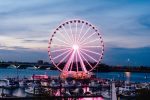
- OVERALL RISK: MEDIUM
- TRANSPORT & TAXIS RISK: MEDIUM
- PICKPOCKETS RISK: HIGH
- NATURAL DISASTERS RISK: LOW
- MUGGING RISK: MEDIUM
- TERRORISM RISK: MEDIUM
- SCAMS RISK: HIGH
- WOMEN TRAVELERS RISK: MEDIUM
Frequently Asked Questions
What happened to Tri-State Zoological Park?
This zoo was near the borders of Maryland, Pennsylvania, and West Virginia.
It closed its operation late in 2022.
It had been open for about 20 years.
The owner had some legal issues, and the animals were getting older.
The Zoo opened in 2002 and was a smaller zoo with just over 100 animals.
Most of the animals at the zoo were rescue animals.
Many of those animals went back to their original owners.
What is the oldest zoo in America?
The oldest zoo in the United States is the Philadelphia Zoo, which was opened on July 1, 1874.
The next year, the Cincinnati Zoo opened.
It gets complicated after that.
The Baltimore Zoo claims to be the third oldest, as does Buffalo, New York.
The Buffalo Museum started out as a private operation in 1875 and grew from there.
The Baltimore Zoo started in 1876 as a formal zoo, before the Buffalo zoo became a normal public facility.
Most people in Baltimore claim theirs is the third oldest.
Some lists put Baltimore’s zoo at No. 8.
The oldest 10 were started between 1874 and 1876.
When is the best time to see animals active?
Most animals are most active in the early morning or late afternoon near sunset.
This is especially true in wildlife areas.
It is largely true in zoos as well, where animals are kept in captivity.
Even at a zoo, you will get better views of animals in the early morning hours.
Why are marshlands so important in Maryland?
There are several wildlife refuges that protect large areas of marshland in Maryland, especially on the peninsula.
Coastal wetlands are vital for many plants and animals.
They are also essential for millions of migratory birds that use the Atlantic Flyway each year, going north or south.
They also protect water quality in the Chesapeake Bay by slowing freshwater that enters the bay, keeping nutrients and sediments on the land.
Why do zoo owners and wildlife experts say not to feed animals?
The food humans consume is generally processed in some way, and that is not good for animals.
It is bad for their digestive system and could make them sick.
Another reason for not feeding animals in the wild is that they will become dependent on humans giving them food.
If humans are not there anymore, they could starve.
How did Baltimore get the National Aquarium?
Congress recognized the Baltimore aquarium in 1978, giving it national status.
The National Aquarium in Washington D.C. closed in 2013, and that left the one in Baltimore as the only national one left.
The National Aquarium in Washington D.C. opened in 1973, and when it closed it was the oldest continually operating aquarium in the United States.
The Aquarium in D.C. was smaller than the one in Baltimore.
It changed locations a few times and was going to have to change again because of renovations to other federal buildings.
